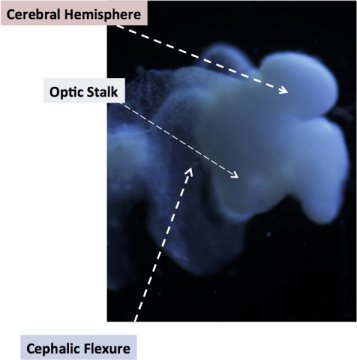Five-week Old Human Brain Grown in a Dish


This image of the lab-grown brain is labeled to show identifiable structures: the cerebral hemisphere, the optic stalk and the cephalic flexure, a bend in the mid-brain region, all characteristic of the human fetal brain. Photo courtesy of The Ohio State University
A research team from Ohio State University has developed a brain in vitro that has the maturity of a five-week old human brain. The brain organoid, grown from adult human skin cells, has all the identifiable structures of a fetal brain. This is the most complete human brain model ever developed. The breakthrough was presented by Rene Anand, Professor of Biological Chemistry and Pharmacology, at the 2015 Military Health System Research Symposium in Ft. Lauderdale, Florida.
Professor Anand conducts studies on brain disorders. For a long time he had been frustrated with the disappointing results when studying human neural disorders in rodent models. He decided to start using pluripotent cells derived from skin cells. Anand developed a proprietary technique to differentiate pluripotent stem cells into cells that specifically belong to the neural tissue, the central nervous system or other brain regions. The organoid was grown in a Petri dish for 15 weeks, the time it took to match the 5-week-old fetal human brain. The brain in the dish contains 99 percent of the genes present in the human fetal brain. It has a spinal cord, all major regions of the brain, multiple cell types, signaling circuitry and even a retina. However, it lacks a vascular system.
Organoid models of brain disorders
Anand and her colleague and research associate Susan McKay are co-founders of the start-up company NeurXstem, which will commercialize the brain organoid platform. Use of brain organoids allows fast, accurate testing of experimental drugs before the clinical trial stage and study of central nervous system disorders. Anand and McKay are creating brain organoid models of Alzheimer’s and Parkinson’s diseases and autism. With added blood supply, the model could be used for stroke therapy studies.
Source: Ohio State University
